
94% of researchers rate our articles as excellent or good
Learn more about the work of our research integrity team to safeguard the quality of each article we publish.
Find out more
SYSTEMATIC REVIEW article
Front. Urol., 13 October 2023
Sec. Male Urology
Volume 3 - 2023 | https://doi.org/10.3389/fruro.2023.1173885
 Zhi Hong Sun1
Zhi Hong Sun1 Xue Wei Ma1†
Xue Wei Ma1† Wei Sun1†
Wei Sun1† Ying Ji Wei1
Ying Ji Wei1 Yi Zhen Li1
Yi Zhen Li1 Dan Wang1
Dan Wang1 Chang Xi Zhou2*
Chang Xi Zhou2* Guo Gang Xu3*
Guo Gang Xu3* Gui Zhi Zhang1*
Gui Zhi Zhang1*Objective: To analyze the effect of different types of disinfectants for perineum and urethral meatus cleaning in preventing catheter-associated asymptomatic bacteriuria and catheter-associated urinary tract infection (CAUTI).
Methods: Chinese and English databases were searched to collect randomized controlled trials (RCTs) of different disinfectants for perineum and urethral meatus cleaning to prevent CAUTI, and the positive rates of urine culture with different cleaning methods were contrasted by network meta-analysis.
Results: A total of 18 RCTs were included in this study to analyze the effect of 10 disinfectants in preventing CAUTI. The disinfectants were 0.1% chlorhexidine (CHG), 0.5% CHG, 2% CHG, 0.1% benzalkonium bromide (DBDAB), 0.05% iodophor, 0.5% iodophor, acidic oxidizing potential water (EOW), normal saline (NS), Shehuang lotion, and sterile water. Meta-analysis showed that the positive rates of urine culture in the 0.5% CHG cluster, EOW cluster, 0.5% iodophor cluster, and Shehuang lotion cluster were remarkably lower than that in the 0.1% DBDAB cluster (P < 0.05). The positive rate of urine culture in the 0.5% CHG cluster was remarkably lower than that in the 0.05% iodophor cluster (P < 0.05), whereas the positive rates of urine culture in the 0.5% CHG cluster, 0.5% iodophor cluster, Shehuang lotion cluster, and EOW were remarkably lower than that in the normal saline cluster (P < 0.05). The positive rate of urine culture in the 0.5% CHG cluster and EOW cluster were remarkably lower than those in the sterile water cluster (P < 0.05). The results of the area under the cumulative ranking probability plot (SUCRA) analysis showed that the probability ranking of the preventive effect of different disinfectants was as follows: 0.5% CHG > Shehuang lotion > EOW > 0.5% Iodophor > 2% CHG > 0.1% CHG > 0.05% Iodophor > Sterile Water > 0.1% DBDAB > Saline.
Conclusion: 0.5% CHG, Shehuang lotion, EOW, and 0.5% iodophor can be used to clean the perineum and urethral meatus in patients with indwelling catheters.
Systematic review registration: Chinese Clinical Trial Registry (ChiCTR), identifier ChiCTR2100052260.
Catheter-associated urinary tract infection (CAUTI) refers to urinary tract infection that occurs between 48 hours after indwelling catheter and 48 hours after catheter removal and is an important component of nosocomial infection, accounting for more than 30% of nosocomial infection cases (1). CAUTI occurs in more than 3% of hospitalized patients and reaches 17. 6% in intensive care unit patients (2, 3). CAUTI can increase the risk of patient death, increase the use of antibacterial drugs, and prolong the length of hospital stay (4). Studies have shown that the mortality rate of CAUTI reaches 2.3% and rises to 9% when bacteremia occurs, with the mortality rate reaching 25% to 60% in patients who develop sepsis (5). Therefore, CAUTI should be actively prevented in clinical practice in patients who undergo urinary catheter indwelling, especially in patients with longer indwelling time and upper risk of infection. Periurethral colonization is an important source of CAUTI, so reducing bacterial colonization of the urethral meatus and surrounding area can reduce the risk of CAUTI (3). At present, a number of studies at home and abroad have investigated the effect of urethral meatus cleaning and perineal cleaning in the prevention of CAUTI, but there is no consensus on which disinfectant has the best effect. This study intends to investigate the effect of different types of disinfectants in preventing CAUTI through network meta-analysis, providing a reference for the selection of cleaning disinfectants for perineum and urethral meatus in patients with indwelling urinary catheters.
The study was approved by the ethics institutional review board of the General Hospital of the Chinese People’s Liberation Army. We searched PubMed, Embase, Medline (via Ovid SP), and Cochrane Library databases from January 2005 to December 2021. Sources of data in both Chinese and English were scanned, including PubMed, Web of Science, Embase, SinoMed, and Cochrane Library for English libraries and the Chinese Journal Full-text Database (CNKI), Wanfang Database, and VIP Database for Chinese datasets. The keywords used in the search were the following: urinary catheter-related urinary tract infection, disinfectant, prevention, chlorhexidine, iodophor, and randomized trial. English search terms were: catheter-associated urinary tract infection, disinfectant, chlorhexidine, iodophor, prevent/prevent, and randomized. MseSH-related terms were searched with subject terms combined with free terms.
Hospitalized patients with indwelling catheters.
Randomized controlled trials (RCTs) of different disinfectants for perineum and urinary meatus cleaning to prevent CAUTI.
Perineum and urethral meatus cleaning was performed using the following disinfectants: 0.1% chlorhexidine (CHG), 0.5% CHG, 2% CHG, 0.1% benzalkonium bromide (DBDAB), 0.05% iodophor, 0.5% iodophor, acidic oxidizing potential water (EOW), normal saline (NS), Shehuang lotion, and sterile water.
Positive urine culture rate.
(1) The study with the broadest sample size included recurring findings for the same study participants.
(2) The antiseptics composition was unclear or could not be defined because cleaning agents were combined.
(3) The data seem to have been inadequate.
(4) The publications were posted in languages other than Chinese or English.
(5) Access to the full transcript was not possible.
(6) Studies including mouse models and evidence from animal models.
(7) The study was of inferior quality (Jadad < 3 points).
Two research personnel searched databases independently for a comprehensive search. We deleted duplicate records, screened the titles and abstracts for relevance, and identified each as excluded or requiring further assessment. We reviewed the full-text articles designated for inclusion and manually checked the references of the retrieved articles and previous reviews to identify additional eligible studies. Discrepancies were resolved by consensus. The following data were extracted from each study: study design, first author, year of publication, sample size, positive urine culture, interventions, comparisons, and outcomes. A third researcher was consulted in case of disagreement between the two investigators.
The assessment of literature quality for each study was based on the modified Jadad scale (6). This scale has a maximum score of 7 and includes four parameters: random sequence generation, allocation concealment, intervention blinding of participants and researchers, and incomplete outcome data. Low and high-quality studies are indicated by Jadad scores of ≤ 3.0 and > 3.0, respectively.
Data analysis was performed using Stata15 software. The odds ratio (OR) was used as the effect statistics for the healing rate and 95% CI was calculated. The agreement between direct evidence and indirect evidence was contrasted by the node-cutting method, and the results of consistency assessment in this study showed P > 0.05, and the consistency model was selected for analysis. Bayesian network model was used to calculate the ranking probability of CAUTI prevention by different disinfectants, and the possibility of each disinfectant becoming the best choice was presented by calculating the area under the cumulative ranking probability plot (SUCRA). Funnel plots were used to analyze the presence of publication bias.
A total of 18 studies were included in this review (Figure 1). There were 14 studies in Chinese and 4 studies in English, with a total of 5,368 cases divided as follows: 2,722 cases in the test cluster (cluster T) and 2,646 cases in the control cluster (cluster C). There were 13 studies with Jadad scores of 3 ~ 7 points and ≥ 4 points, and 72.2% of them were high-quality studies (Table 1).
This analysis compared the preventive effect of 10 disinfectants on CAUTI. The network relationship diagram of different disinfectants is shown in Figure 2. The nodes and edges (connections) show both direct and indirect comparisons. The size of the bubble and the thickness of the connections indicate the size and strength of head-to-head comparisons. It can be seen that the comparison between sterile water and 0.5% iodophor is the most common in this analysis.
In cases where a loop connected three intersecting disinfectants, the node-splitting method was used to calculate the inconsistency of the model. The method separated the evidence concerning certain comparisons into direct and indirect evidence, and the inconsistency was reported by its Bayesian P value. For the majority of our results, most of the P values from the node-splitting method were above 0.05.
Node analysis of consistent results showed that there was no remarkable variance in the positive rate of urine culture between direct comparisons and indirect comparisons (P > 0. 05), and consistent model analysis could be used (Table 2).
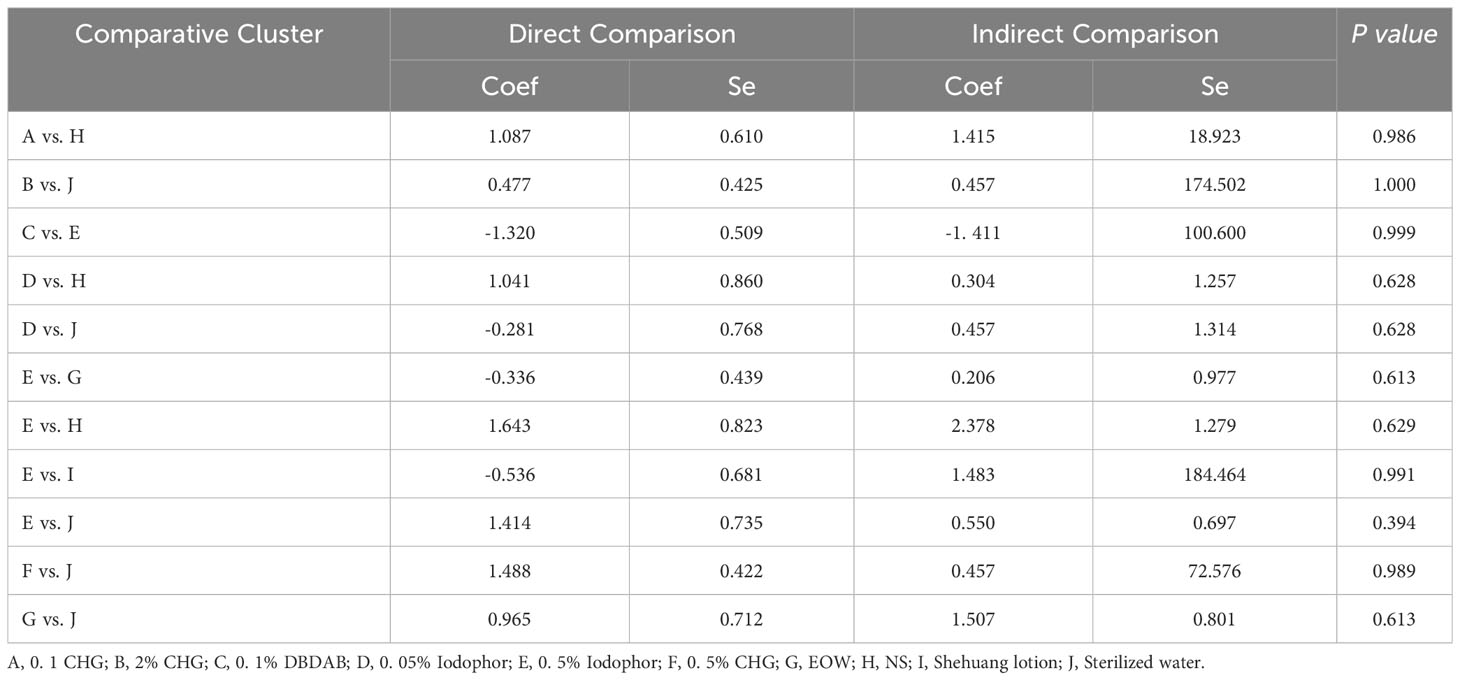
Table 2 Consistency of direct comparisons and indirect comparisons in node analysis of positive rate of urine culture with different disinfectants.
A comparison of positive rates of urine culture with the use of different disinfectants is shown in Figure 3. The positive rate of urine culture in the 0.5% CHG cluster, EOW cluster, 0.5% iodophor cluster, and Shehuang lotion cluster was remarkably lower than that in the 0.1% DBDAB cluster (P < 0.05). The positive rate of urine culture in the 0.5% CHG cluster was remarkably lower than that in 0.05% iodophor cluster (P < 0.05), whereas the positive rates of urine culture in the 0.5% CHG cluster, 0.5% iodophor cluster, Shehuang lotion cluster, and EOW were remarkably lower than those in the normal saline cluster (P < 0.05). The positive rate of urine culture in the 0.5% CHG cluster and EOW cluster were remarkably lower than those in the sterile water cluster (P < 0. 05), and no variance was registered between the other two clusters (P > 0.05).
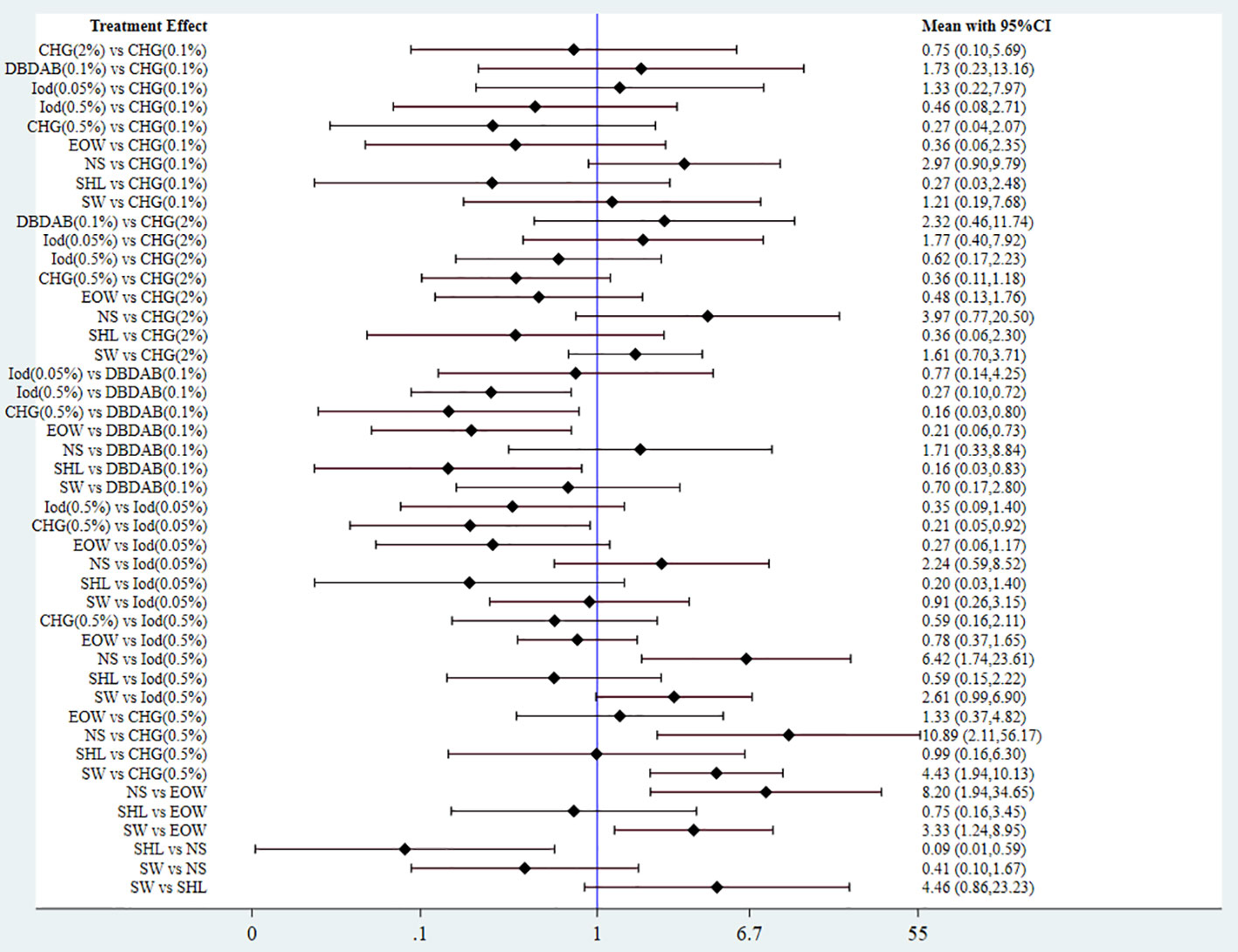
Figure 3 Forest map of meta-analysis of the effect of different disinfectants in preventing CAUTI. SHL, shehuang Lotion; Iod, Iodophor; SW, sterilized water.
The probability ranking of different types of disinfectants in preventing catheter-associated asymptomatic bacteriuria and CAUTI is displayed in Table 3. Shehuang lotion has the highest probability of preventing catheter-associated asymptomatic bacteriuria and CAUTI, with a probability ranking of 41.5%, followed by 0.5% CHG (39.2%); 0.5% CHG has the highest probability of ranking second, 27.7%; EOW has the highest probability of ranking third, 30. 4%; and normal saline has the worst probability of preventing catheter-associated asymptomatic bacteriuria and CAUTI, 63.4%. The ranking results of SUCRA are shown in Table 4; the larger the SUCRA, the better the effect of preventing catheter-associated asymptomatic bacteriuria and CAUTI. The ranking, from high to low, was as follows: 0.5% CHG > Shehuang Lotion > EOW > 0.5% iodophor > 2% CHG > 0.1% CHG > 0.05% iodophor > sterile water > 0.1% DBDAB > normal saline. SUCRA plots are shown in Figure 4.
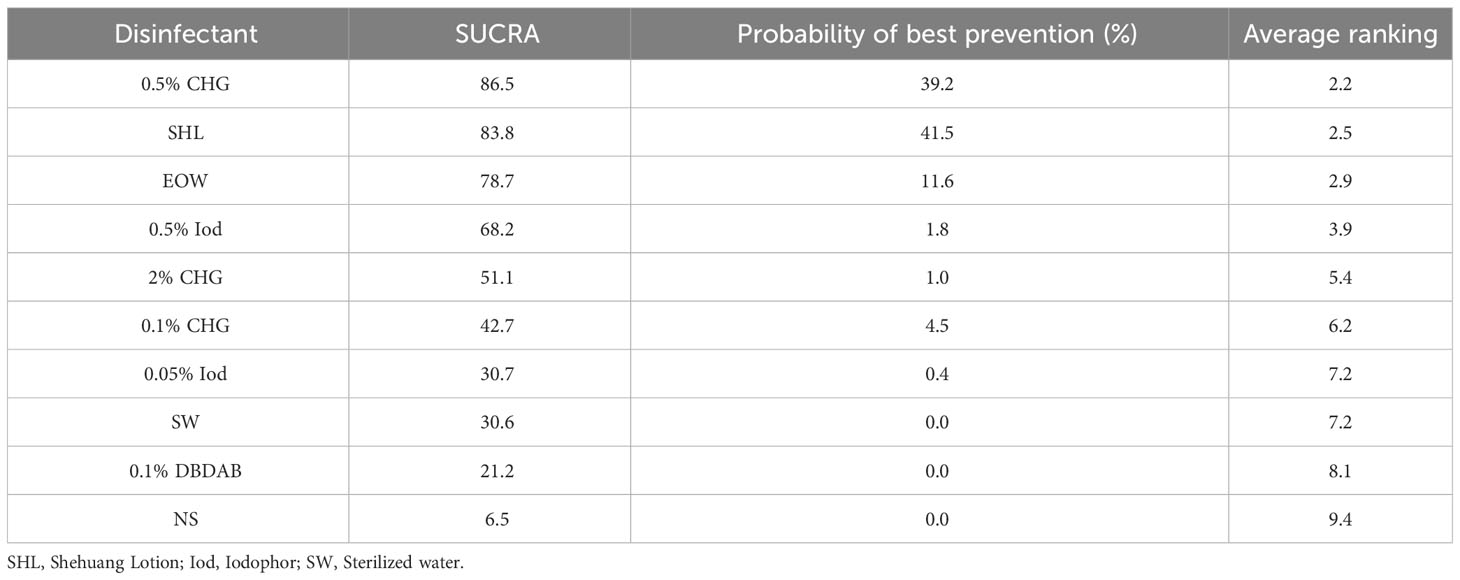
Table 4 SUCRA ranking of catheter-associated asymptomatic bacteriuria and CAUTI prevention effects of different disinfectants.
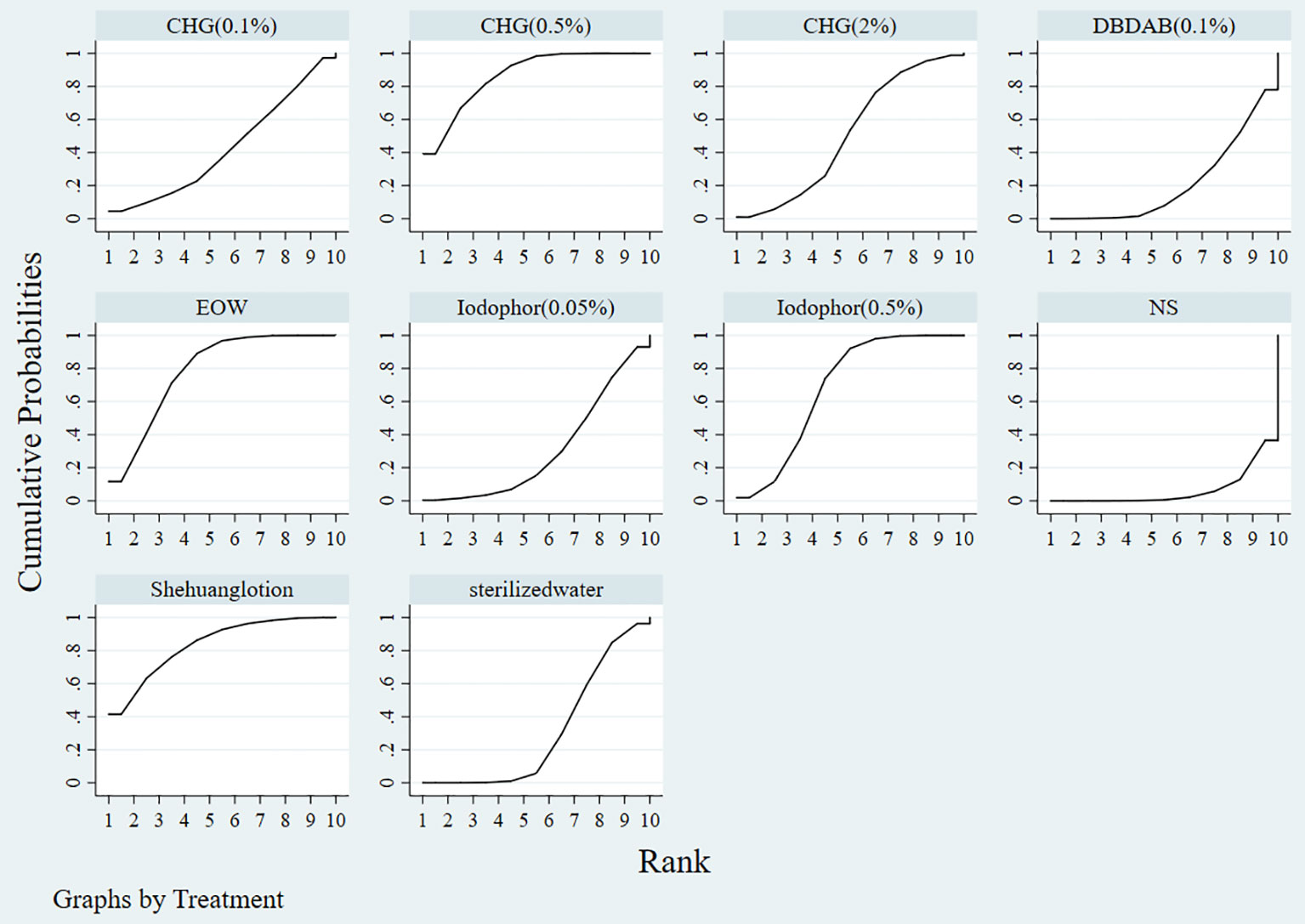
Figure 4 SUCRA Diagram of the Effect of different Disinfectants in Preventing Catheter-associated asymptomatic bacteriuria and CAUTI.
A funnel plot of publication bias is shown in Figure 5, and the distribution of each study is basically symmetrical, suggesting no remarkable publication bias.
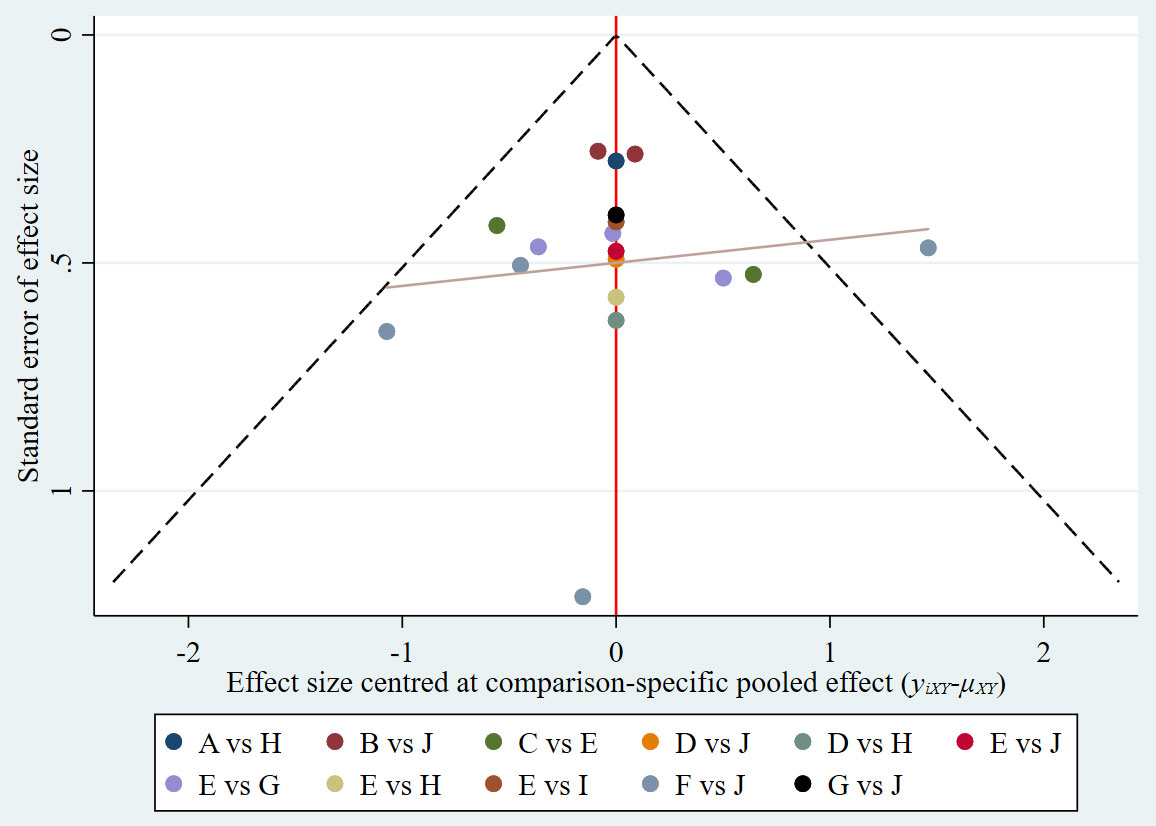
Figure 5 Funnel plot. A: 0. 1 CHG; B: 2% CHG; C: 0. 1% DBDAB; D: 0. 05% Iodophor; E: 0. 5% Iodophor; F: 0. 5% CHG; G: EOW; H: NS; I: Shehuang lotion; J: Sterilized water.
This analysis examined 10 disinfectants for cleaning the perineum and urethra and preventing catheter-associated urinary tract infections (CAUTI). The evidence network map of different disinfectants for preventing CAUTI shows that the most common disinfectants in this analysis are sterile water and 0.5% iodophor. The forest map and probability ranking showed that the top four disinfectants for the prevention of catheter-related urinary tract infections were chlorhexidine (CHG) 0.5%, snake yellow lotions, acid oxidation potential water (EOW), and iodophor 0.5%.
CAUTIs are associated with increased morbidity, mortality, longer hospital stays, and increased hospitalization costs for patients and the health system. CAUTIs are also associated with a higher risk of antimicrobial resistance (AMR), making it difficult to treat patients. AMR in UTIs is also increasing globally, which further emphasizes the necessity of developing interventions to reduce the incidence of CAUTI (25).
Previous studies or guidelines for CAUTI included catheter materials, such as antibiotic-coated catheters and silver ion catheters. There was also a push for education and training for indwelling catheter operators and those responsible for catheter maintenance. Evidence suggests that reducing bacterial colonization around the urethral area may reduce the risk of CAUTIs (26). Some studies have found that cleaning the perineum with chlorhexidine before an indwelling catheter is placed and reducing bacterial colonization around the urethra may reduce the risk of CAUTI (27). Most of the studies included in this paper compare the effects of cleaning the perineum with two disinfectants on catheter-associated infections. There have been no studies comparing multiple disinfectants at the same time in the hope of finding a safer and more effective disinfectant for preventing catheter-associated infections.
Chlorhexidine (CHG), one of the top four disinfectants found in this analysis (28), is a broad-spectrum and highly effective biguanide that can destroy the plasma membrane of the cell wall of pathogenic microorganisms, thereby rapidly killing pathogens and reducing the number of bacterial colonies on the skin surface, and consequently reducing the risk of infection. CHG is less irritating to the skin and can be more widely applied. CHG is an antimicrobial agent, and long-term use can easily lead to the development of resistance. The high cost will increase the financial burden on patients.
The snake yellow lotion is a kind of Chinese medicine preparation, its main effective components are snake seed, yellow cypress, and matrine. Among them, the snake seed is a commonly used external medicine in traditional Chinese medicine clinical settings, which has the function of sterilization and relieving itching. Phellodendri has a strong inhibitory effect on pyogenic bacteria, especially gram-positive coccus such as Staphylococcus aureus, Epidermococcus, and Streptococcus pyogenes. Matrine has the function of relieving inflammation and detoxifying, killing insects, and relieving itching (15). The results of this analysis showed that washing the perineum with snake yellow lotion can effectively prevent CAUTI, but the relevant literature is limited and there is a need for further research and exploration.
Studies have shown that EOW has a rapid disinfection effect because of chemical disinfection based on physical disinfection, as well as has a strong killing effect on bacterial nutrient morphology and spores (17, 29, 30). EOW can directly destroy cell metabolic enzymes, resulting in bacterial rupture and death, thereby more thoroughly clearing bacteria around the urethral tract (16, 17). After that, EOW can be reduced to ordinary water for a period of time, and as it has no irritating effect on the skin and mucosa of patients, it is safe and does not increase the discomfort of patients. Adverse reactions such as irritating burning pain, redness, and swelling pain are rare, and the irritation produced by EOW is less than that of iodophor (17), so it is an ideal cleaning agent for the perineum and urethral opening.
The top four disinfectants selected in this analysis were 0.5% chlorhexidine (CHG), snake yellow lotion, acidic oxidizing potential water (EOW), and 0.5% iodophor. This analysis provides a variety of possibilities for clinicians to choose the treatment strategy for catheter-associated urinary tract infections.
This analysis was the first to compare multiple disinfectants at the same time, but the definitions of urinary tract infections (that is, based on symptoms or bacterial positive cultures) vary from study to study. The timing of perineal disinfection with the included disinfectants was either before or after the indwelling catheter. Previous studies have mentioned that the type of catheter had a certain contribution to catheter-associated urinary tract infection. Only two papers (13, 15) included in this study mentioned the silicone catheter used, while other studies did not mention the type of catheter used. We expect to further investigate the role of catheter type and perineal skin cleaning before and after catheter indwelling in the prevention of catheter-associated urinary tract infections in future studies.
Conclusion: 0.5% CHG, snake yellow lotions, EOW, and 0.5% iodophor can be used to clean the perineum and urethra in patients with indwelling catheterization, and this action can reduce the risk of CAUTI. However, there are few studies included in this analysis, and further studies are needed to support the effectiveness and safety of 0.5% CHG, snake yellow lotions, EOW, and 0.5% iodoprene in preventing CAUTI.
The original contributions presented in the study are included in the article/supplementary material. Further inquiries can be directed to the corresponding author.
ZS, GZ, CZ, and GX conceptualized the manuscript and edited subsequent versions. ZS, GZ, XM, and WS wrote the first draft. XM, WS, YW, YL, and DW collected and analyzed data. CZ and GX contributed ideas to the texts. All authors approved the final manuscript.
This work was supported by the National Key Research and Development Programs of China (2020YFC2005402).
Thanks to every member of this team, and thanks for the support provided by the National Key Research and Development Programs of China fund.
The authors declare that the research was conducted in the absence of any commercial or financial relationships that could be construed as a potential conflict of interest.
All claims expressed in this article are solely those of the authors and do not necessarily represent those of their affiliated organizations, or those of the publisher, the editors and the reviewers. Any product that may be evaluated in this article, or claim that may be made by its manufacturer, is not guaranteed or endorsed by the publisher.
1. Flores-Mireles A, Hreha TN, Hunstad DA. Pathophysiology, treatment, and prevention of catheter-associated urinary tract infection. Top Spinal Cord Inj Rehabil (2019) 25(3):228–40.
2. Rebmann T, Greene LR. Preventing catheter-associated urinary tract infections: An executive summary of the Association for Professionals in Infection Control and Epidemiology, Inc, Elimination Guide. Am J Infect Control (2010) 38(8):644–6.
3. Ercole FF, Macieira TGR, Wenceslau LCC, Martins AR, Campos CC, Chianca TCM. Integrative review: evidences on the practice of intermittent/indwelling urinary catheterization. Rev Lat Am Enfermagem (2013) 21(1):459–68.
4. Atkins L, Sallis A, Chadborn T, Shaw K, Schneider A, Hopkins S, et al. Reducing catheter-associated urinary tract infections: a systematic review of barriers and facilitators and strategic behavioural analysis of interventions. Implement Sci (2020) 15(1):1–22.
5. Tenke P, Köves B, Johansen TE. An update on prevention and treatment of catheter-associated urinary tract infections. Curr Opin Infect Dis (2014) 27(1):102–7.
6. Oremus M, Oremus C, Hall GB, McKinnon MC. & ECT & Cognition Systematic Review Team. Inter-rater and test–retest reliability of quality assessments by novice student raters using the Jadad and Newcastle–Ottawa Scales. BMJ Open (2012) 2(4):e001368.
7. Bo Xu, Hui W, Xufang. G. Comparison of the effect of disinfection and cleaning nursing of urethral meatus in patients with indwelling urinary catheter. Chin J Nurs (2006) 41(11):1044–5.
8. Xiaohui L, Hongxian Z. Comparison of the effect of urethral meatus nursing methods in patients with indwelling catheterization. J Nurses' Refresher Stud (2008) 23(19):1806–7.
9. Ye S, Ruichen W. Observation on the effect of iodophor in preventing urinary tract infection caused by indwelling urinary catheter. Chin J Nosocomial Infect (2008) 18(04):524–5.
10. Shuping He, Zhenghua R, Dacui W. Observation on the effect of iodophor lubrication in preventing urinary tract infection of indwelling urinary catheter. Western Med (2010) 22(03):567–8.
11. Xiaoxia Wu. Effect of clean perineal washing in patients with indwelling urinary catheter. China Med Herald (2015) 12(11):141–4.
12. Jianmei L. Comparison of the efficacy of iodophor and bromogeramine in the prevention of urinary tract infection caused by long-term indwelling urinary catheter. China Pharm Co. Ltd. (2011) 20(21):70–1.
13. Xingyun Z, Cuifen J, Jinli L, Xuezhu L. Effect of different methods of cleaning the urethral meatus on patients with reflex bladder dysfunction indwelling urinary catheter in spinal cord injury. Chin Clin Nurs (2016) 8(04):301–3.
14. Chunxiu Li, Yong T, Daqiong W, Jishu T, Changbin L, Xiaohua G, et al. Acidic electrolyzed oxidizing water for the prevention of urinary tract infection in patients undergoing indwelling catheterization. J Nurs (2014) 29(05):6–8.
15. Chunqing C, Zhe B, Shuang ZXi, Lijun F. Application of perineal irrigation with Shehuang lotion in patients undergoing indwelling catheterization after transurethral surgery. Nurse refresher magazine (2017) 32(15):1392–4.
16. Yan L, Bin L, Zhihan. Y. Observation of acidic oxidizing potential water in preventing urinary tract infection in elderly patients undergoing indwelling catheterization. Chin J Nosocomial Infect (2015) 25(18):4214–4215 + 4218.
17. Shuzhen B, Huaizhen Li, Ruixia J, Xueli B, Jie B. Study on the preventive effect of acidic oxidizing potential water on urinary tract infection in patients undergoing indwelling catheterization in endocrinology department. Chin J Nosocomial Infect (2016) 26(01):216–217 + 226.
18. Ying X, Yanwei Z, Hui Y, Ye He, Ying W, Xiangfeng Li, et al. Effect of chlorhexidine perineal care in preventing catheter-related urinary tract infection in elderly ICU patients. Chin J Nosocomial Infect (2021) 31(04):598–601.
19. Fasugba O, Cheng AC, Gregory V, Graves N, Koerner J, Collignon P, et al. Chlorhexidine for meatal cleaning in reducing catheter-associated urinary tract infections: a multicentre stepped-wedge randomised controlled trial. Lancet Infect Dis (2019) 19(6):611–9.
20. Cheung K, Leung P, Wong YC, To OK, Yeung YF, Chan MW, et al. Water versus antiseptic periurethral cleansing before catheterization among home care patients: a randomized controlled trial. Am J Infect Control (2008) 36(5):375–80.
21. Popovich KJ, Hota B, Hayes R, Weinstein RA, Hayden MK. Effectiveness of routine patient cleansing with chlorhexidine gluconate for infection prevention in the medical intensive care unit. Infect Control Hosp Epidemiol (2009) 30(10):959–63.
22. Bleasdale SC, Trick WE, Gonzalez IM, Lyles RD, Hayden MK, Weinstein RA. Effectiveness of chlorhexidine bathing to reduce catheter-associated bloodstream infections in medical intensive care unit patients. Arch Intern Med (2007) 167(19):2073–9.
23. Shukun S, Fenghong W, Huiqing H, Jinru Z. Investigation on the relationship between urethral meatus nursing methods and urinary tract infection during indwelling catheterization and evaluation of patient comfort and satisfaction. Hebei Med J (2015) 37(16):2542–4.
24. Xiaohua C, Wuping Li, Bing L, Yu W, Lili S, Xiaona. Z. Comparison of therapeutic effects of different bladder irrigation solutions and modalities in ICU patients with urinary tract infection. J Nurs (2016) 31(15):9–12.
25. Gould CV, Umscheid CA, Agarwal RK, Kuntz G, Pegues DA, Healthcare Infection Control Practices Advisory Committee. Guideline for prevention of catheter-associated urinary tract infections 2009. Infect Control Hosp Epidemiol (2010) 31(4):319–26.
26. Nicolle LE. Catheter associated urinary tract infections. Antimicrob Resist Infect Control (2014) 3(1):1–8.
27. Galiczewski JM. Interventions for the prevention of catheter associated urinary tract infections in intensive care units: an integrative review. Intensive Crit Care Nurs (2016) 32(1):1–11.
28. Mitchell BG, Fasugba O, Cheng AC, Gregory V, Koerner J, Collignon P, et al. Chlorhexidine versus saline in reducing the risk of catheter associated urinary tract infection: a cost-effectiveness analysis. Int J Nurs Stud (2019) 97(1):1–6.
29. Limin He, Bin X. Meta-analysis of chlorhexidine urethral orifice disinfection in the prevention of catheter-related urinary tract infection in critically ill patients. China Pharm Co. Ltd. (2021) 30(19):105–9.
Keywords: catheter-related urinary tract infection, chlorhexidine, iodophor, acidic oxidizing potential water, meta-analysis
Citation: Sun ZH, Ma XW, Sun W, Wei YJ, Li YZ, Wang D, Zhou CX, Xu GG and Zhang GZ (2023) Effect of different disinfectants on preventing asymptomatic bacteriuria and catheter-related urinary tract infection: a network meta-analysis. Front. Urol. 3:1173885. doi: 10.3389/fruro.2023.1173885
Received: 25 February 2023; Accepted: 13 September 2023;
Published: 13 October 2023.
Edited by:
Jan Svihra, Comenius University, SlovakiaReviewed by:
Pablo Abad López, Hospital Clínico San Carlos, SpainCopyright © 2023 Sun, Ma, Sun, Wei, Li, Wang, Zhou, Xu and Zhang. This is an open-access article distributed under the terms of the Creative Commons Attribution License (CC BY). The use, distribution or reproduction in other forums is permitted, provided the original author(s) and the copyright owner(s) are credited and that the original publication in this journal is cited, in accordance with accepted academic practice. No use, distribution or reproduction is permitted which does not comply with these terms.
*Correspondence: Gui Zhi Zhang, eXVuanVrZTMwMUAxNjMuY29t; Guo Gang Xu, Z3VvZ2FuZ194dUBxcS5jb20=; Chang Xi Zhou, emhvdWNoYW5neGkyMDAyQGFsaXl1bi5jb20=
†These authors share first authorship
Disclaimer: All claims expressed in this article are solely those of the authors and do not necessarily represent those of their affiliated organizations, or those of the publisher, the editors and the reviewers. Any product that may be evaluated in this article or claim that may be made by its manufacturer is not guaranteed or endorsed by the publisher.
Research integrity at Frontiers

Learn more about the work of our research integrity team to safeguard the quality of each article we publish.